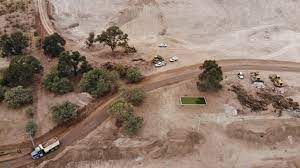
The governor of Mexico’s northern state of Sonora acknowledged Tuesday that a secrecy-shrouded train project was an army undertaking that has not yet submitted any environmental impact statement, months after construction had already started.
The rail link between the port of Guaymas and the border city of Nogales threatens to cut through and damage environmentally-sensitive conservation lands.
Sonora Gov. Alfonso Durazo justified the new rail line project saying it would solve the problem of a rail line that passed through the center of Nogales by diverting rail traffic outside the city.
But while the state is partially financing the project, Durazo said it is “being carried out by the Defense department,” adding that the state’s operational role is limited to helping the Army secure the rights-of-way.
The Sonora state government is trying to convert Guaymas, on the Gulf of California, into a major container port, but the current railway connection to the United States cuts the city of Nogales in half.
The project illustrates the power that Mexico’s president Andrés Manuel López Obrador has given to the army, which has been allowed to sidestep normal permitting and environmental standards. This has been the case of the Maya Train tourist rail line on the Yucatan peninsula, which cut a swath through the jungle.
In the face of court challenges and criticism, López Obrador in 2021 passed a law stating the projects of importance to “national security” would not have to submit impact statements until up to a year after they start construction.
Under Mexico’s environmental laws, sidestepping impact assessments ought to be “completely illegal,” said said Alex Olivera, a senior scientist with the Center for Biological Diversity. “But this is AMLO’s government, so probably they will say that it is ‘strategic infrastructure’” like the Maya Train, and therefore exempt.
Opponents have been unable to get even the most basic information on the train line, with no federal, local or state authority willing to take responsibility for the $350 million project to build 40 miles (63 kilometers) of train line.
Even though parts are already under construction and government contractors have begun felling trees and bulldozing the path for the railroad toward the Aribabi ranch — home to a rare combination of black bears and jaguars — no environmental impact statement has ever been filed.
“Because it is a strategic project, it is the responsibility of the Environment Department and we have a year to submit the environmental impact, and that is well under way,” Durazo said.
Durazo stressed the line was part of an “integrated plan” for transporting freight from Guaymas to the U.S., but that plan appears to have neglected existing train lines north of the border, where Omaha, Nebraska-based Union Pacific operates the line running into Nogales.
“Union Pacific has no plans (for) moving the track in Nogales,” a company spokesperson told The Associated Press.
Local residents also feel left out of Durazo’s plan saying there has been no official communication or consultation. The project is not mentioned on any state or federal government websites, or in Sonora state’s development plans.
Omar del Valle Colosio, Sonora state’s chief development officer, said all rights-of-way were being negotiated with residents.
“The project being carried out is only being done with the authorization of the public,” Del Valle Colosio said Tuesday.
But local residents say the state’s infrastructure and urban development department has offered to buy portions of some properties for as little as 1.80 pesos (10 U.S. cents) per square meter.
According to a map leaked by a local official in the spring, the project will create a second rail line for a portion of the existing route between Nogales and the port of Guaymas, this time following the Cocospera river south before cutting through the west perimeter of the Aribabi ranch and then pulling west, into Imuris.
Locals say the route rides roughshod over their farms’ irrigation canals and threatens the reservoir that provides water for the township’s 12,500 residents.
In addition to disrupting wildlife that rely on the river, construction will also cut up an important migration corridor over the Azul and El Pinito mountains for ocelots, black bears and jaguars, according to the Center for Biological Diversity.




